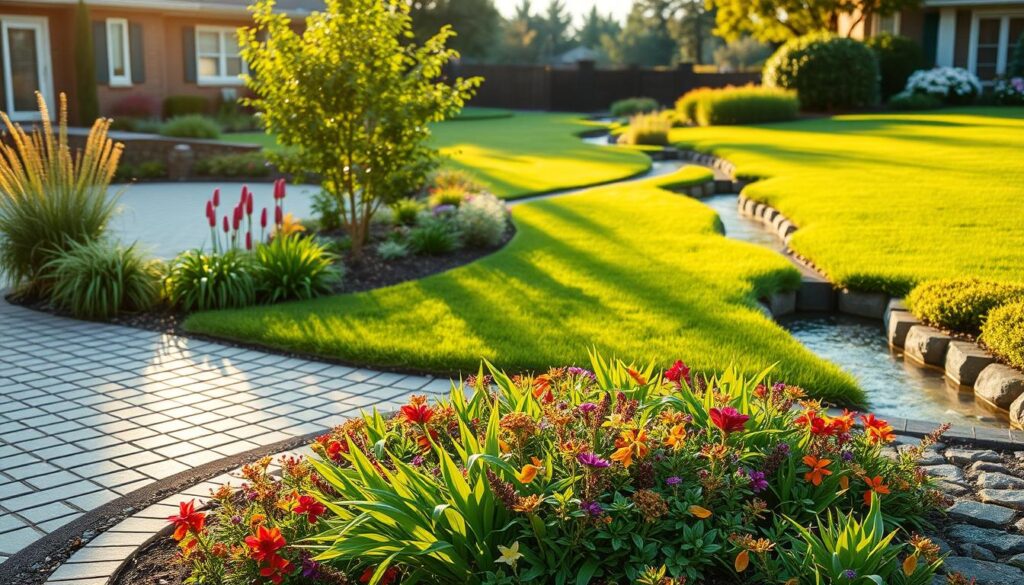Are traditional drainage systems putting your property at risk of flooding? As urbanization increases, the strain on conventional drainage infrastructure grows, leading to a higher risk of flooding and water pollution.
Sustainable Drainage Systems (SuDS) offer an innovative solution by mimicking natural processes to manage surface water runoff. SuDS not only reduce the risk of flooding but also improve water quality and enhance biodiversity. For more information on SuDS, you can visit this resource.
By implementing SuDS, property owners can protect their assets from flooding while contributing to a more sustainable environment. Effective stormwater management is crucial for reducing the impact of urbanization.
Key Takeaways
- SuDS reduce the risk of flooding by managing surface water runoff.
- They improve water quality by reducing pollution from runoff.
- SuDS enhance biodiversity by creating habitats for wildlife.
- Effective stormwater management is crucial for sustainable development.
- SuDS can help protect natural flow regimes in watercourses.
Introduction to Sustainable Drainage Systems
As urbanization continues to grow, the importance of sustainable urban drainage systems (SUDS) cannot be overstated. Urban development often leads to increased impervious surfaces, resulting in higher runoff rates and greater pressure on traditional drainage systems. SUDS offer a more eco-friendly approach by mimicking natural drainage processes, thereby reducing the impact of urbanization on flooding and water quality.
SUDS are designed to manage rainfall at the source, rather than relying solely on traditional piped drainage systems. This approach not only helps in reducing surface water flooding but also improves water quality by filtering out pollutants. Moreover, SUDS can enhance the amenity and biodiversity value of the environment, making them a valuable tool in urban planning.
The benefits of SUDS are multifaceted. According to a report by leading civil engineering companies, SUDS can significantly reduce the burden on urban drainage infrastructure, thereby decreasing the likelihood of flooding. Additionally, SUDS can improve water quality by allowing rainwater to infiltrate the ground, reducing the amount of pollutants that enter watercourses.
“Sustainable drainage systems are not just a necessity for managing urban runoff; they are an opportunity to enhance the urban environment.” –
The key components of SUDS include green roofs, permeable pavements, rain gardens, and bio-swales. Each of these components plays a crucial role in managing rainfall and reducing the impact of urbanization on the environment.
| Component | Function | Benefits |
|---|---|---|
| Green Roofs | Absorb rainfall, reduce runoff | Reduce urban heat island effect, improve air quality |
| Permeable Pavements | Allow rainwater to infiltrate | Reduce surface water flooding, improve water quality |
| Rain Gardens | Capture and filter rainwater | Enhance biodiversity, improve water quality |
| Bio-swales | Slow down runoff, filter pollutants | Reduce erosion, improve water quality |
In conclusion, SUDS are a vital component of modern urban planning, offering numerous benefits for both the environment and communities. By understanding and implementing SUDS, we can create more sustainable, resilient cities.
Importance of Sustainable Drainage Systems in Urban Planning
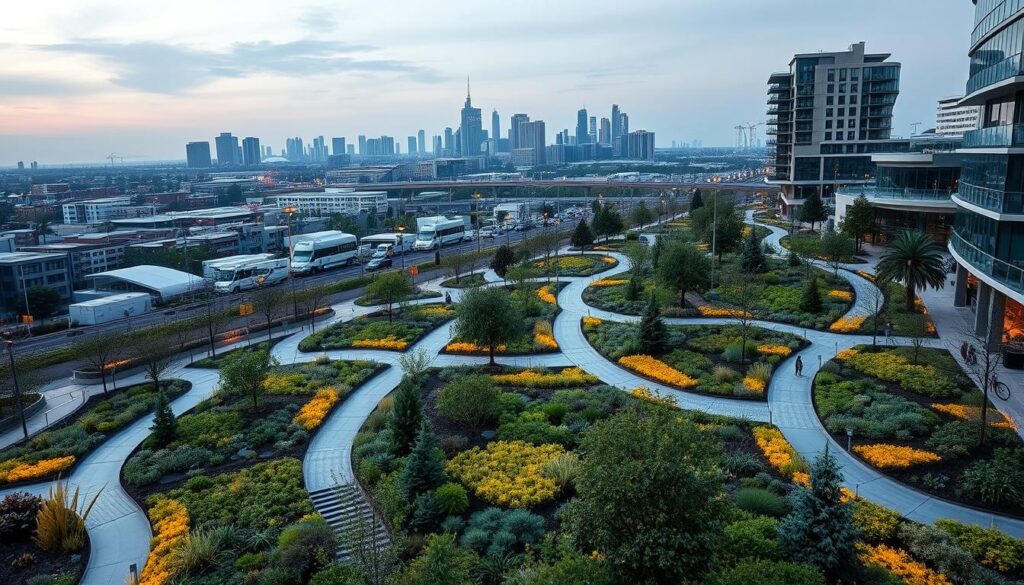
Sustainable Drainage Systems are a key component of water-sensitive urban design, offering multiple benefits for urban environments. By integrating SuDS into urban planning, cities can mitigate the challenges posed by urbanization, such as increased stormwater runoff and decreased water quality.
Benefits for the Environment
One of the primary benefits of SuDS is their ability to reduce the environmental impact of urbanization. By managing stormwater runoff at the source, SuDS can help prevent flooding, reduce pollution, and protect aquatic habitats. As noted by urban planning experts, “SuDS can play a crucial role in maintaining healthy water cycles and mitigating the effects of climate change.”
“Sustainable Drainage Systems are not just a necessity for managing stormwater; they are an opportunity to enhance the aesthetic and ecological value of urban spaces.”
SuDS can also contribute to biodiversity by creating habitats for wildlife in urban areas. This not only enhances the environmental quality but also provides residents with green spaces that improve their quality of life.
Enhancing Property Values
In addition to their environmental benefits, SuDS can also enhance property values by providing attractive habitats for wildlife and improving the aesthetic value of urban environments. Properties near well-designed SuDS features, such as rain gardens or green roofs, are often more desirable due to their enhanced visual appeal and recreational opportunities.
Implementing SuDS as part of a low-impact development strategy can lead to increased property values, making neighborhoods more attractive to potential residents and businesses. This, in turn, can stimulate local economic growth and contribute to the overall vitality of the community.
Key Components of Sustainable Drainage Systems
Effective Sustainable Drainage Systems rely on a combination of green infrastructure elements, including green roofs, permeable pavements, rain gardens, and bio-swales. These components work together to manage surface water runoff and provide eco-friendly drainage solutions.
The key components of Sustainable Drainage Systems can be broken down into several categories:
Green Roofs
Green roofs are designed to capture and retain rainwater, reducing the amount of surface water runoff. They also provide insulation, reducing energy costs and creating habitats for wildlife.
Permeable Pavements
Permeable pavements allow rainwater to percolate through the surface, reducing runoff and filtering out pollutants. They are an effective solution for managing stormwater management in urban areas.
Rain Gardens
Rain gardens are shallow depressions that collect and filter rainwater, allowing it to infiltrate the ground. They are often planted with native vegetation, enhancing biodiversity and providing a natural eco-friendly drainage solution.
Bio-swales
Bio-swales are vegetated channels that convey and filter rainwater, removing pollutants and sediments. They are an effective way to manage surface water runoff and improve water quality.
For more information on Sustainable Drainage Systems, you can visit the SDCC website, which provides detailed insights into the implementation and benefits of SuDS.
- Green roofs capture and retain rainwater
- Permeable pavements reduce runoff and filter pollutants
- Rain gardens collect and filter rainwater
- Bio-swales convey and filter rainwater, improving water quality
By incorporating these components, Sustainable Drainage Systems provide effective stormwater management and eco-friendly drainage solutions, enhancing the overall sustainability of urban environments.
Types of Sustainable Drainage Systems
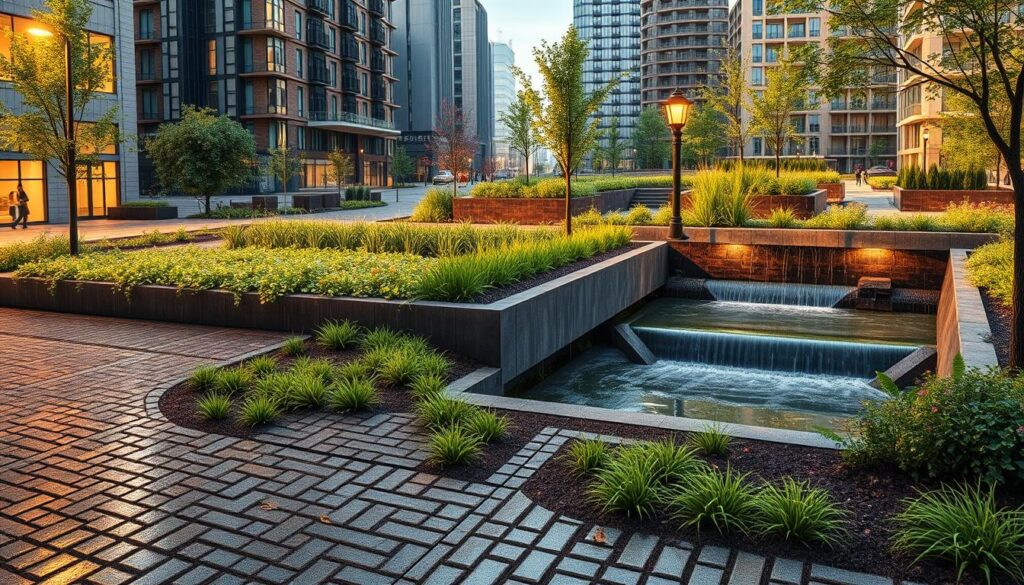
SUDS can be broadly classified into several types, each serving a unique purpose in managing urban water runoff. The selection of a particular type depends on site-specific conditions, including topography, soil type, and urban planning requirements.
Surface Water Management
Surface water management involves techniques that handle water runoff at the surface. This includes permeable pavements, rain gardens, and green roofs. These systems are designed to reduce the immediate impact of urban runoff by allowing water to infiltrate or be stored temporarily.
Subsurface Water Management
Subsurface water management focuses on managing water below the surface. Techniques such as bio-swales and infiltration trenches help in reducing runoff by facilitating infiltration into the soil. These systems are particularly effective in areas with suitable soil conditions.
Combination Systems
Combination systems integrate multiple SUDS techniques to achieve optimal water management. For instance, a project might incorporate both permeable pavements and rain gardens to manage surface runoff effectively. These systems are highly adaptable and can be tailored to meet specific urban drainage challenges.
The choice of SUDS type is critical and depends on factors such as land use, soil characteristics, and local regulations. By understanding the different types of SUDS available, urban planners and developers can make informed decisions to implement effective sustainable urban drainage systems.
Benefits of Implementing Sustainable Drainage Systems
Sustainable Drainage Systems offer a multifaceted approach to managing stormwater, improving both environmental quality and community resilience. By adopting eco-friendly drainage solutions, communities can mitigate the adverse effects of urbanization on water cycles.
Flood Risk Reduction
One of the primary benefits of SuDS is their ability to reduce flood risk. By managing stormwater at the source, SuDS minimize the burden on traditional drainage infrastructure, thereby decreasing the likelihood of urban flooding. As noted by experts, “Effective stormwater management is crucial for preventing flood damage and ensuring public safety.”
Water Quality Improvement
SuDS also play a significant role in improving water quality. Through natural processes, these systems can filter out pollutants from stormwater, enhancing the quality of water that enters local water bodies. This not only benefits aquatic ecosystems but also contributes to a healthier environment for community members.
Green infrastructure, a key component of SuDS, helps in maintaining water quality by reducing runoff and promoting groundwater recharge.
Habitat Creation
Furthermore, SuDS contribute to habitat creation, providing ecological benefits that enhance biodiversity. Rain gardens, bio-swales, and other components of SuDS can serve as habitats for various species, supporting local ecosystems. As a result, these systems can be a valuable tool in urban planning, promoting ecological balance alongside human development.
In conclusion, the implementation of Sustainable Drainage Systems yields numerous benefits, from reducing flood risk and improving water quality to creating habitats for wildlife. By embracing these eco-friendly drainage solutions, communities can move towards more sustainable and resilient urban environments.
Designing Sustainable Drainage Systems
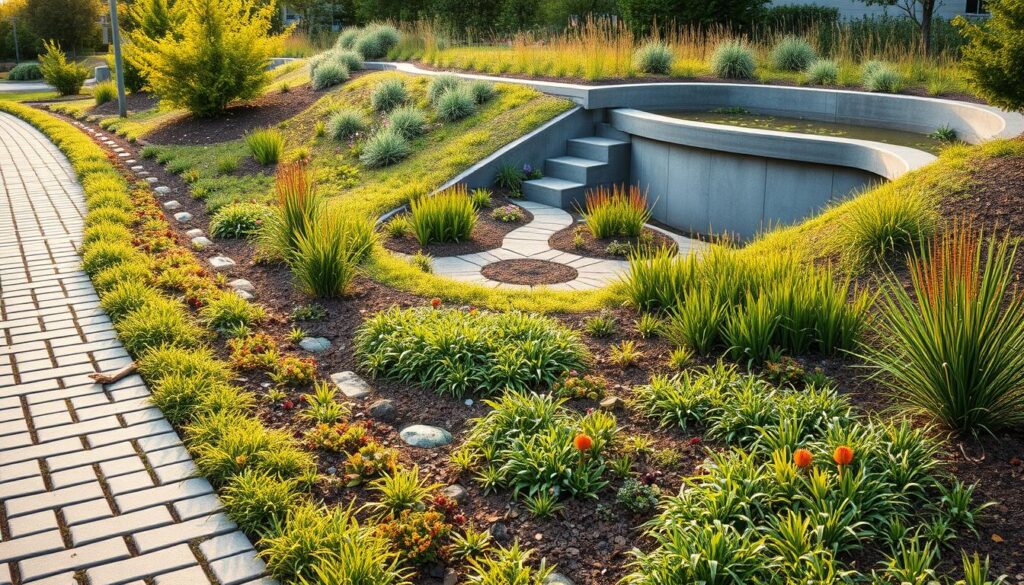
The design of sustainable drainage systems involves a multi-faceted approach, considering both environmental and urban planning factors. This holistic approach ensures that SuDS are effective, efficient, and tailored to the specific needs of a site.
Site Assessment and Analysis
A thorough site assessment is crucial for designing effective SuDS. This involves analyzing the site’s topography, soil type, and existing drainage patterns. Key factors to consider include:
- Soil permeability and infiltration rates
- Topography and slope
- Existing water bodies and drainage paths
- Climate and rainfall patterns
By understanding these factors, designers can develop SuDS that are tailored to the site’s specific conditions, enhancing their performance and sustainability.
Selecting Appropriate Techniques
The selection of SuDS techniques depends on the site assessment and analysis. Various techniques can be employed, including green roofs, permeable pavements, rain gardens, and bio-swales. Each technique has its advantages and is suited to different site conditions.
Some key considerations for selecting techniques include:
- The level of flood risk and water quality improvement required
- The site’s soil and topography characteristics
- The available space and land use constraints
- The need for biodiversity enhancement and habitat creation
Compliance with Local Regulations
Ensuring compliance with local regulations and guidelines is essential for the successful implementation of SuDS. This involves familiarizing oneself with relevant policies, standards, and best practices. Key aspects to consider include:
- Local building codes and zoning regulations
- Environmental protection policies
- Water management guidelines
- Community engagement and participation requirements
By adhering to these regulations, designers can ensure that their SuDS designs are not only effective but also compliant with legal and regulatory requirements.
Maintenance of Sustainable Drainage Systems
Regular upkeep is vital for the continued effectiveness of eco-friendly drainage solutions. Sustainable Drainage Systems (SuDS) are designed to manage stormwater runoff in a way that mimics natural processes, reducing the burden on urban drainage infrastructure and minimizing environmental impact. However, like any other infrastructure, SuDS require maintenance to function optimally.
Routine Inspection Practices
Routine inspections are a critical component of SuDS maintenance. These inspections help identify potential issues before they become major problems, ensuring that the system continues to operate as intended. Inspections should check for signs of wear, damage, or blockages in components such as permeable pavements, rain gardens, and bio-swales.
Cleaning and Upkeep
Cleaning and upkeep are essential for maintaining the functionality and aesthetic appeal of SuDS. This includes removing debris and sediment from surface features, checking and repairing any damage to structures, and ensuring that vegetation is healthy and appropriately managed. For more information on the latest trends in green infrastructure, including SuDS, visit Discover the Latest Trends in Green.
Long-term Performance Monitoring
Long-term performance monitoring is crucial for understanding how SuDS are functioning over time and identifying areas for improvement. This involves tracking parameters such as water quality, flood risk reduction, and habitat creation. By monitoring performance, stakeholders can make informed decisions about maintenance needs and potential upgrades or modifications to the system.
In conclusion, the maintenance of Sustainable Drainage Systems is a multifaceted task that requires careful planning, regular inspections, and ongoing upkeep. By prioritizing maintenance, communities can ensure that their SuDS continue to provide effective stormwater management and contribute to a more sustainable urban environment.
Case Studies of Successful Implementations
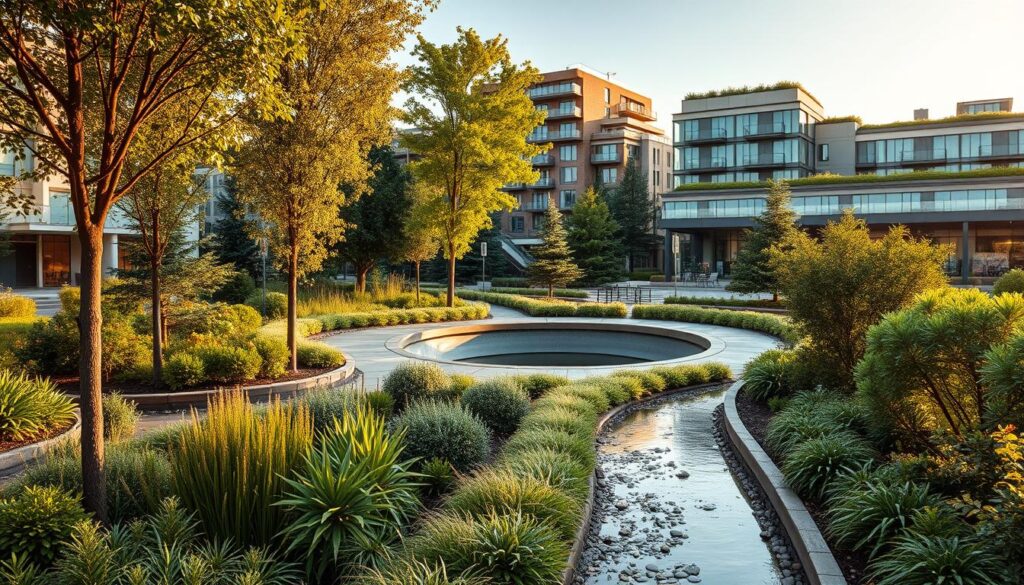
Case studies from around the world highlight the successful integration of sustainable urban drainage systems (SUDS) in diverse contexts, from urban centers to rural landscapes. These examples demonstrate the versatility and effectiveness of SUDS in managing stormwater runoff, improving water quality, and enhancing urban environments.
Urban Examples
In urban areas, SUDS have been instrumental in mitigating the effects of urbanization on stormwater runoff. For instance, the city of Chicago has implemented a comprehensive SUDS program that includes green roofs, permeable pavements, and rain gardens. These initiatives have not only reduced stormwater runoff but also improved air quality and enhanced biodiversity within the city.
Another notable example is the London Borough of Greenwich, where SUDS have been integrated into new developments to manage surface water runoff. The use of permeable paving and green infrastructure has significantly reduced the burden on traditional drainage systems, minimizing the risk of flooding and improving water quality.
Rural Applications
In rural areas, SUDS have been adapted to suit the unique challenges and opportunities presented by the landscape. For example, in agricultural regions, SUDS have been used to reduce runoff and improve water quality. In Australia, farmers have implemented SUDS techniques such as contour plowing and vegetated swales to manage stormwater and reduce erosion.
A case study from rural America highlights the use of SUDS in restoring wetlands and improving water quality. The project involved the creation of wetlands and the implementation of low-impact development techniques to manage stormwater runoff, resulting in improved biodiversity and water quality.
Lessons Learned from Each Case
The case studies from both urban and rural areas provide valuable insights into the design, implementation, and maintenance of SUDS. Key lessons include the importance of thorough site assessment, the need for community engagement, and the benefits of integrating SUDS with other green infrastructure.
- Thorough site assessment is crucial for identifying the most effective SUDS techniques.
- Community engagement and education are vital for the successful implementation of SUDS.
- Integrating SUDS with other green infrastructure can enhance their benefits and improve overall environmental outcomes.
By examining these successful implementations, we can better understand how to apply SUDS principles in various contexts, ultimately contributing to more sustainable and resilient water management practices.
Challenges in Adopting Sustainable Drainage Systems
Despite the benefits of eco-friendly drainage solutions, the adoption of Sustainable Drainage Systems (SuDS) faces numerous obstacles. The integration of SuDS into urban and rural landscapes requires a multifaceted approach that addresses various challenges.
Financial Barriers
One of the primary challenges in adopting SuDS is the financial barrier. The initial investment for implementing SuDS can be higher compared to traditional drainage systems. However, it’s essential to consider the long-term benefits and cost savings that SuDS offer, such as reduced maintenance costs and enhanced property values.
Funding opportunities and incentives can play a crucial role in mitigating the financial barriers. Governments and local authorities can offer grants, subsidies, or tax incentives to encourage the adoption of SuDS.
Technical Limitations
Technical limitations also pose a significant challenge to the adoption of SuDS. The design and implementation of SuDS require specialized knowledge and expertise. Site-specific assessments are crucial to determine the most appropriate SuDS techniques for a particular area.
The complexity of integrating SuDS with existing infrastructure can be a technical hurdle. However, advancements in technology and the development of new materials are continually improving the feasibility and effectiveness of SuDS.
Community Resistance
Community resistance is another challenge that needs to be addressed. Educating the public about the benefits of SuDS and involving them in the planning process can help alleviate concerns and foster support.
Community engagement initiatives, such as workshops and public meetings, can provide valuable opportunities for stakeholders to understand the advantages of SuDS and contribute to their design and implementation.
By understanding and addressing these challenges, it’s possible to facilitate the wider adoption of SuDS, ultimately enhancing stormwater management and contributing to more sustainable urban environments.
Regulations and Best Practices
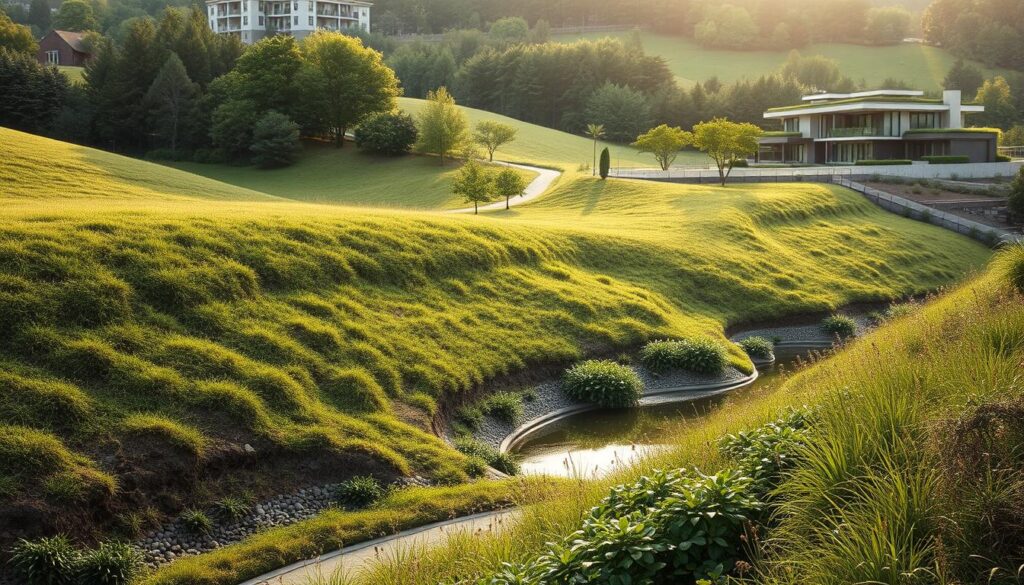
The effective adoption of SuDS requires a comprehensive understanding of the governing regulations and guidelines. Sustainable drainage systems are subject to various local and federal regulations that dictate their design, implementation, and maintenance.
Local and Federal Guidelines
Regulations governing SuDS vary significantly across different regions. At the federal level, guidelines often provide a framework that local authorities can build upon or adapt to their specific needs. For instance, in the United States, the Environmental Protection Agency (EPA) plays a crucial role in setting national standards that influence local regulations. Understanding these guidelines is essential for ensuring compliance and achieving the desired environmental benefits.
Local guidelines, on the other hand, are tailored to address specific regional challenges, such as flood risk management or water quality improvement. These regulations can be more stringent than federal guidelines and are critical for the successful implementation of SuDS at the community level. For more detailed information on regulations for sustainable drainage systems, you can visit this resource.
Best Management Practices (BMPs)
Best Management Practices (BMPs) are techniques or measures used to manage and mitigate the impact of urban runoff. BMPs are crucial for the effective implementation of SuDS, as they provide a practical framework for achieving environmental goals. BMPs can include a wide range of strategies, from structural measures like permeable pavements and green roofs to non-structural practices such as public education campaigns.
The selection of appropriate BMPs depends on various factors, including local climate, soil conditions, and community needs. By adopting BMPs, communities can not only comply with regulations but also enhance the overall sustainability of their drainage systems.
In conclusion, understanding and adhering to regulations and best practices are fundamental to the successful implementation of sustainable drainage systems. By navigating the complex regulatory landscape and adopting effective BMPs, communities can create resilient and sustainable SuDS that benefit both the environment and public health.
Community Involvement in Sustainable Drainage Systems
Engaging the community is vital for the long-term success of eco-friendly drainage solutions. Community involvement not only fosters a sense of ownership among local residents but also ensures that Sustainable Drainage Systems (SuDS) are effectively maintained and operated.
Engaging Local Residents
Engaging local residents is a critical step in the successful implementation of SuDS. This can be achieved through public awareness campaigns, community meetings, and educational programs that highlight the benefits of SuDS, such as improved stormwater management and enhanced biodiversity.
By involving residents in the planning process, SuDS projects can be tailored to meet the specific needs of the community, thereby increasing their effectiveness and acceptance.
Educational Initiatives
Educational initiatives play a pivotal role in promoting the understanding and adoption of SuDS. Schools and community groups can be engaged through workshops, seminars, and hands-on activities that demonstrate the importance of sustainable drainage practices.
These initiatives not only educate the community but also inspire future generations to value and implement eco-friendly drainage solutions.
Volunteer Opportunities
Providing volunteer opportunities is another effective way to engage the community in SuDS projects. Activities such as planting rain gardens, maintaining permeable pavements, and monitoring water quality can foster a sense of community and responsibility.
Volunteer programs also offer a platform for residents to contribute to the success of SuDS, enhancing their connection to the project and to each other.
In conclusion, community involvement is a cornerstone of successful SuDS implementation. By engaging local residents, promoting educational initiatives, and offering volunteer opportunities, communities can work together to create effective and sustainable drainage solutions.
Comparison with Traditional Drainage Systems
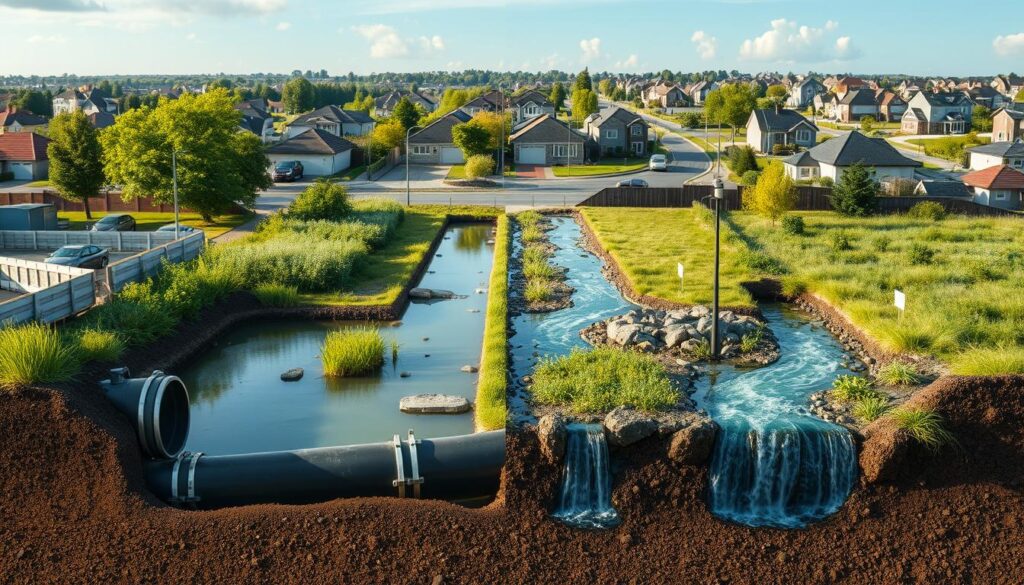
The shift towards Sustainable Drainage Systems is driven by their numerous advantages over traditional drainage solutions. As urban areas continue to expand, the need for effective and sustainable water management practices becomes increasingly important.
Cost Analysis
One of the primary benefits of SUDS is their potential for cost savings. Unlike traditional drainage systems, which often require significant upfront investment and ongoing maintenance costs, SUDS can be designed to be more cost-effective. For instance, the use of permeable pavements and green roofs can reduce the need for costly underground infrastructure.
Initial investment in SUDS may be comparable to or slightly higher than traditional systems, but the long-term savings on maintenance and potential flood damage can be substantial.
Environmental Impact Assessment
SUDS offer a more environmentally friendly alternative to traditional drainage systems. By promoting infiltration and reducing runoff, SUDS help to protect water quality and preserve natural habitats. This approach not only benefits the environment but also enhances biodiversity in urban areas.
- Reduced stormwater runoff
- Improved water quality
- Enhanced biodiversity
Flexibility and Adaptability
Another significant advantage of SUDS is their flexibility and adaptability. Unlike traditional drainage systems, which are often designed with a fixed capacity, SUDS can be tailored to accommodate changing rainfall patterns and urban development. This flexibility makes SUDS an attractive option for areas experiencing climate change impacts.
| Criteria | SUDS | Traditional Systems |
|---|---|---|
| Cost Effectiveness | High | Low |
| Environmental Impact | Positive | Negative |
| Flexibility | High | Low |
In conclusion, SUDS provide a more sustainable, cost-effective, and environmentally friendly solution compared to traditional drainage systems. Their ability to adapt to changing conditions makes them an ideal choice for modern urban planning.
Innovations in Sustainable Drainage Systems
Innovations in SuDS are revolutionizing the way we manage stormwater, offering more effective and sustainable solutions. The continuous evolution in this field is driven by the need for better environmental outcomes and the integration of new technologies.
New Technologies and Materials
Recent advancements in SuDS have been marked by the development of new materials and technologies that enhance their performance. For instance, the use of permeable pavements made from recycled materials not only reduces stormwater runoff but also supports sustainable construction practices.
Key innovations include:
- Advanced permeable pavement systems
- Green roofs with integrated rainwater harvesting
- Bio-engineered solutions for pollutant removal
These technologies not only improve the efficiency of SuDS but also contribute to more eco-friendly drainage solutions.
| Technology | Description | Benefits |
|---|---|---|
| Permeable Pavements | Allows water to percolate through the surface | Reduces stormwater runoff, recharges groundwater |
| Green Roofs | Vegetated roofs that absorb rainwater | Reduces urban heat island effect, manages stormwater |
| Bio-swales | Landscaped features that manage stormwater runoff | Filters out pollutants, enhances biodiversity |
Future Trends and Directions
Looking ahead, the future of SuDS is likely to be shaped by further technological innovations and a greater emphasis on sustainability and resilience. As cities continue to grow, the integration of SuDS with other urban infrastructure will become increasingly important.
Future trends may include:
- Integration with smart city technologies
- Use of artificial intelligence for predictive maintenance
- Development of new materials with enhanced performance characteristics
By embracing these innovations, cities can create more sustainable and resilient stormwater management systems.
Sustainable Drainage Systems and Climate Change

The increasing frequency of extreme weather events underscores the importance of sustainable drainage systems in enhancing urban resilience. As climate change continues to manifest through more intense and frequent weather events, the role of SuDS in mitigating these impacts becomes ever more critical.
Adapting to Extreme Weather
Sustainable drainage systems are designed to manage rainfall and surface water runoff in a way that mimics natural processes. By doing so, they help cities adapt to the changing climate by reducing the risk of flooding and alleviating pressure on traditional drainage infrastructure.
Key strategies for adapting to extreme weather through SuDS include:
- Implementing permeable pavements to absorb rainwater
- Creating green roofs to retain rainfall
- Designing rain gardens and bio-swales to slow down runoff
Resilience in Urban Environments
Urban environments are particularly vulnerable to the impacts of climate change, including increased flooding and heat island effects. SuDS can enhance urban resilience by not only managing water resources more effectively but also by providing additional benefits such as improved water quality and enhanced biodiversity.
The multifaceted benefits of SuDS make them an essential component of climate change adaptation strategies in urban areas. By integrating SuDS into urban planning, cities can create more sustainable, resilient environments that are better equipped to handle the challenges posed by climate change.
Integrating Sustainable Drainage Systems with Other Green Infrastructure
SuDS can be effectively integrated with other green infrastructure to provide multiple benefits for urban environments. This integration not only enhances stormwater management but also contributes to a more sustainable and resilient urban ecosystem.
Synergies with Urban Forestry
Urban forestry plays a crucial role in urban planning, and when combined with SuDS, it can significantly improve stormwater management. Trees help absorb rainwater, reduce runoff, and mitigate the urban heat island effect.
According to a study, integrating urban forestry with SuDS can lead to a significant reduction in stormwater runoff. As noted by Martin Young in his article on integrating green infrastructure, such synergies are crucial for effective urban drainage systems.
“The integration of green infrastructure with urban drainage systems is not just beneficial; it’s essential for creating resilient and sustainable urban environments.”
Collaboration with Landscape Architecture
Landscape architecture plays a vital role in designing urban spaces that are not only aesthetically pleasing but also functional and sustainable. By collaborating with landscape architects, SuDS can be seamlessly integrated into urban designs, enhancing both the functionality and beauty of urban spaces.
| Benefits | SuDS | Urban Forestry | Landscape Architecture |
|---|---|---|---|
| Stormwater Management | Effective runoff reduction | Rainwater absorption | Designs that incorporate SuDS |
| Biodiversity | Habitat creation | Ecosystem support | Integration of green spaces |
| Aesthetic Appeal | Varied design options | Enhanced urban landscapes | Beautiful and functional designs |
Conclusion: Embracing Sustainable Solutions for a Better Future
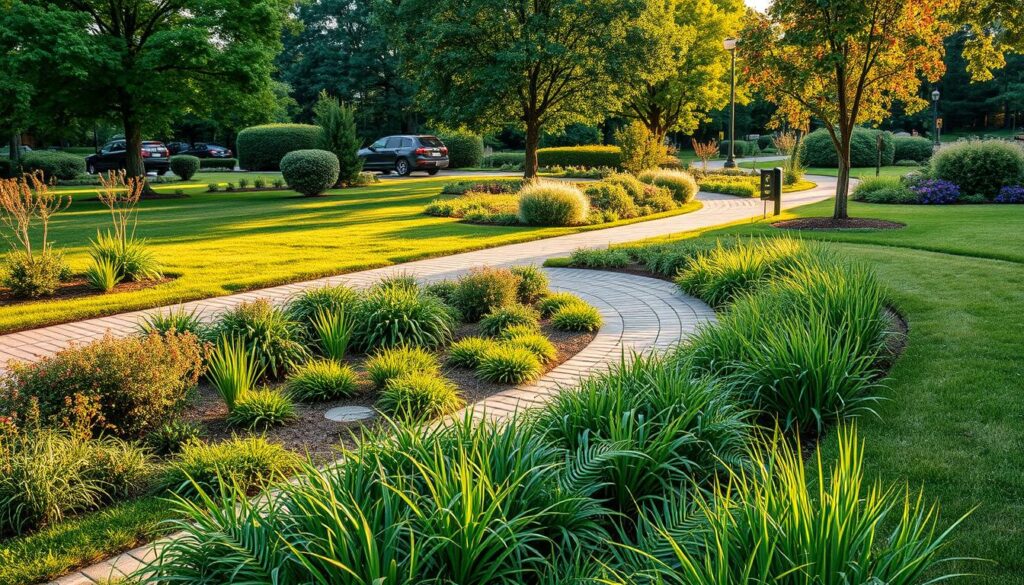
As we move towards a more sustainable future, the role of Sustainable Drainage Systems (SuDS) cannot be overstated. SuDS offer a sustainable and effective solution for managing surface water runoff, providing multiple benefits for the environment and communities.
The implementation of eco-friendly drainage solutions is crucial in addressing the challenges posed by climate change and urbanization. By reducing flood risk, improving water quality, and creating habitats, SuDS contribute significantly to achieving a more resilient and sustainable urban environment.
It is essential to continue innovating and investing in SuDS to enhance their effectiveness and adaptability. This includes adopting new technologies and materials, as well as promoting community involvement and education on the benefits of sustainable drainage practices.
In conclusion, embracing sustainable drainage systems is a vital step towards creating a better future for our communities and the environment. By prioritizing SuDS, we can build more resilient cities and ensure a sustainable legacy for generations to come.
Call to Action: Get Started on Your Sustainable Drainage Journey
Embracing sustainable drainage systems (SuDS) is a crucial step towards creating a more resilient and environmentally friendly future. By adopting SuDS, individuals and communities can effectively manage rainwater, reduce flood risk, and improve water quality.
To get started, it’s essential to understand the simple yet effective SuDS process, which involves slowing, storing, and filtering water. This can be achieved through various features such as filter trenches, swales, and storage ponds. For more information on designing and maintaining SuDS, refer to resources like the SuDS guidance document.
Residents and local communities can play a vital role in monitoring and maintaining SuDS, ensuring they function effectively. Simple actions like litter picking, checking drains, and removing surface debris can make a significant difference. By working together, we can create a more sustainable and resilient environment, leveraging the benefits of green infrastructure and SuDS.
